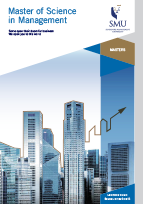
When fashion e-retailer Zalora first started operating in some countries in Southeast Asia, some of its deliveries to far-flung locations had to be made using canoes — a colourful detail shared by the company’s chief revenue officer, Alessio Romeni, during the first Industry Dialogue Series webinar conducted by the SMU Master of Science in Management (MiM) Executive Leadership Committee, titled Emerging Trends in eCommerce.
Speaking on the topic, Romeni relayed the anecdote to illustrate the fact that Southeast Asia still presents considerable logistical challenges for e-commerce players.
But figuring out how to meet these challenges may well yield rich rewards. The Southeast Asia e-commerce market is currently worth US$38 billion. That is a small fraction of the global US$3.2 trillion e-commerce market, “but that is going to change pretty quickly”, said Mr Romeni.
That’s because Southeast Asia has the highest compounded annual growth rate in the world, with its market projected to grow over 30 per cent in the next five years. Added to that, COVID-19 has accelerated the growth of e-commerce in the region since online shopping became much more of a necessity during lockdowns.
“In the past six to nine months, there have been three to five years of growth,” Mr Romeni noted. “And as recovery starts, more businesses will invest in digital.”
Joining him as speakers in the webinar were Michael Hofer, Director of eCommerce and Digital for Zuellig Pharma; and Vaibhav Bhargava, Senior Product Lead for Grab.
The implications of Southeast Asia’s e-commerce trends
The region’s distinct trends include fragmented and highly competitive markets; very fast growth for video, streaming and gaming content as drivers for traffic, engagement and sales; and younger consumers’ increasing willingness to pay a premium price for products and companies that champion sustainability.
Understanding and harnessing these trends will be key to the success of companies operating in the regional e-commerce space. And, given the projected rapid growth of this market, the customer inclinations and corresponding innovations that emerge here are also likely to shape the overall e-commerce industry in distinctive ways.
Machine learning and artificial intelligence will be the norm
These technologies are “not novel or optional anymore”, said Mr Bhargava. “Every industry is going to use them, or be disrupted by them.”
In Grab’s case, those who have grown extremely familiar with the company’s GrabFood app during these homebound times would already know that its homepage is personalised according to the user’s previous orders and searches. Such personalisation “is going to get better as data science models get better”, said Mr Bhargava.
“Technology is going to get better at predicting what users want and also create operational efficiency for e-commerce companies.”
Natural language processing (NLP) is one example. This branch of AI helps computers understand text and spoken words and has already been used to automate the tagging process for GrabFood’s participating restaurants so that those who serve burgers, for example, surface when a user searches for “burgers”.
But building NLP models for different languages and dialects is complex, and that is a challenge highly relevant to a multilingual region like Southeast Asia. “The good news is, the world knows how important Southeast Asia is, and there will be time spent on building the tools to solve these problems,” Mr Bhargava believes.
The outlook for B2B e-commerce
Mr Hofer gauged the B2B e-commerce sector to be about 15 to 20 years behind the B2C sector. “There is a lot of catching-up to do, but the advantage is we can leverage what the B2C sector has already tested,” he believed. “We have realised the need to accelerate.”
That said, B2B e-commerce is a different ballgame entirely. In the pharmaceuticals industry, for instance, “there are multiple decision-makers involved when orders are made, and the pricing, delivery and return processes are more complex. It is more about deeper relationships with a smaller customer base. We focus on retention rather than marketing.”
Forthcoming innovations and experiments in this field are likely to include leveraging small pharmacies as warehouses to improve distribution efficiency and developing one-stop purchasing platforms for customers.
Needed: an agile mindset
In short, “competition is very fierce and things change very quickly,” said Mr Romeni of the e-commerce industry, particularly in Southeast Asia. “We may not necessarily know what’s going to happen, but we need to be ready to pivot.”
Currently, many e-commerce companies are taking steps to build on what they have learned and gained during the pandemic. That includes thinking about ways to retain customers who became first-time online shoppers during lockdowns, transitioning into contactless deliveries, and building more localised and flexible supply chains.
To prepare for a career in this fast-moving field, knowledge of technology is essential, the speakers agreed. That doesn’t mean a business student needs to learn how to code, but he or she must understand how relevant technologies work and keep track of emerging technologies that may impact their jobs. As Mr Hofer remarked, for those working in more traditional sectors, the ability to translate the implications of technology for their company and colleagues will be a particularly valuable skill.
The outlook for e-commerce is indeed bright for Southeast Asia — with growth accelerated by more consumers in the region carrying out online transactions during COVID-19. And brands can clearly stand out in the highly cut-throat digital economy by investing in richer, more personalised experiences, informed by breakthroughs in retail technology.
Speak to our Admissions Advisors
Lee Kong Chian School of Business
Postgraduate Admissions
Graduate Programmes Office
50 Stamford Rd, Singapore 178899
Tel: +65 6828 0882
